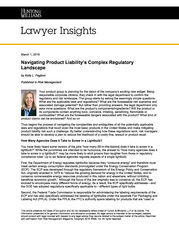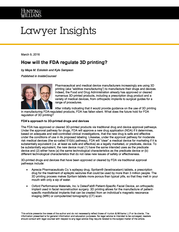How Your CGL Policy May Help with Trademark Infringement Litigation, Risk Management Magazine – June 14, 2016
Hunton & Williams
Description
How Your CGL Policy May Help with Trademark Infringement Litigation
by Syed Ahmad and Jennifer White
Risk Management Magazine | June 2016
litigation damages and attorney’s fees, or encourage the insurer to contribute to or outright pay the cost of
settling the underlying litigation.
Avoiding Exclusions
Policyholders also need a little creativity — and a whole lot of attention to detail — if they hope to dodge
common policy exclusions. Insurers are likely to throw the kitchen sink at what may bar coverage. But,
facts matter. Exclusions that appear on their face to prevent a category of coverage, in fact, may not
apply, depending on the facts alleged in the underlying action or what is proved.
For example, last year, in E.S.Y., Inc., et al.
v. Scottsdale Insurance Company, a Florida federal court held that “knowing violation” and “infringement” exclusions did not apply to lawsuits involving allegations of intent and knowledge in the context of advertising injury. A clothing manufacturer sued the policyholder, a Miami-based clothing retailer, for copyright and trademark violations involving the sale of garments with hang tags and labels bearing the trademarked “Liquid Energy Shield Mark.” The retailer’s insurer denied coverage on the grounds that the policy excluded copyright/trademark infringement and knowing violations of another’s rights.
The court rejected the insurer’s argument that the underlying claims arose from trademark infringement such that the IP exclusion would apply. Rather, the trade dress infringement claims were sufficiently distinct from the trademark to avoid the exclusion. In addition, the knowing violation exclusion did not apply because the causes of action in the underlying complaint were not for intentional harm and, thus, did not require proof of knowledge or intent. Likewise, in Selective Insurance Company of the Southeast v.
Creation Supply, Inc. last year, an Illinois state court required the insurer of a felt-tipped marker manufacturer to defend against claims of trademark infringement, violation of trade dress and unfair competition arising from the marketing of a square-bodied marker. The policyholder argued that the underlying claims fell within the policy’s “advertising injury” coverage because the unique packaging and floor-stand display were “advertising” within the meaning of the policy.
The court agreed and rejected the insurer’s argument that the trademark exclusion would bar coverage. Although the complaint was styled as a “trademark infringement” action, the allegations related to trade dress — i.e., the product’s “total image” — which was covered by the policy and, thus, resulted in the duty to defend. Securing Coverage IP litigation will arrive on the doorstep of most innovators; good ideas beget competitors and copycats. Having good support in the wings makes confronting litigation easier and, ideally, less costly. Moreover, by recognizing opportunities for coverage in the face of policy-imposed obstacles, good coverage counsel can help pass the cost of litigation and settlement to the insurer, who was contracted to cover the policyholder in the first place. Syed Ahmad is a partner at Hunton & Williams LLP.
His practice focuses on insurance coverage, reinsurance matters and other business litigation. Ahmad represents clients in connection with disputes involving general liability, errors and omissions, and directors and officers policies, as well as clients in matters involving coverage for professional liability claims. He may be reached at (703) 714-7676 or sahmad@hunton.com. Jennifer White is an associate at Hunton & Williams LLP.
Her practice focuses on complex civil litigation, with an emphasis on insurance coverage and reinsurance matters. White litigates civil matters in federal and state court. She has represented individuals, local governments, and commercial entities from a diverse range of industries, including insurance, energy, consumer products, food and beverages and real estate.
She may be reached at (703) 714-7411 or jewhite@hunton.com. © 2016 Hunton & Williams LLP 3 .
v. Scottsdale Insurance Company, a Florida federal court held that “knowing violation” and “infringement” exclusions did not apply to lawsuits involving allegations of intent and knowledge in the context of advertising injury. A clothing manufacturer sued the policyholder, a Miami-based clothing retailer, for copyright and trademark violations involving the sale of garments with hang tags and labels bearing the trademarked “Liquid Energy Shield Mark.” The retailer’s insurer denied coverage on the grounds that the policy excluded copyright/trademark infringement and knowing violations of another’s rights.
The court rejected the insurer’s argument that the underlying claims arose from trademark infringement such that the IP exclusion would apply. Rather, the trade dress infringement claims were sufficiently distinct from the trademark to avoid the exclusion. In addition, the knowing violation exclusion did not apply because the causes of action in the underlying complaint were not for intentional harm and, thus, did not require proof of knowledge or intent. Likewise, in Selective Insurance Company of the Southeast v.
Creation Supply, Inc. last year, an Illinois state court required the insurer of a felt-tipped marker manufacturer to defend against claims of trademark infringement, violation of trade dress and unfair competition arising from the marketing of a square-bodied marker. The policyholder argued that the underlying claims fell within the policy’s “advertising injury” coverage because the unique packaging and floor-stand display were “advertising” within the meaning of the policy.
The court agreed and rejected the insurer’s argument that the trademark exclusion would bar coverage. Although the complaint was styled as a “trademark infringement” action, the allegations related to trade dress — i.e., the product’s “total image” — which was covered by the policy and, thus, resulted in the duty to defend. Securing Coverage IP litigation will arrive on the doorstep of most innovators; good ideas beget competitors and copycats. Having good support in the wings makes confronting litigation easier and, ideally, less costly. Moreover, by recognizing opportunities for coverage in the face of policy-imposed obstacles, good coverage counsel can help pass the cost of litigation and settlement to the insurer, who was contracted to cover the policyholder in the first place. Syed Ahmad is a partner at Hunton & Williams LLP.
His practice focuses on insurance coverage, reinsurance matters and other business litigation. Ahmad represents clients in connection with disputes involving general liability, errors and omissions, and directors and officers policies, as well as clients in matters involving coverage for professional liability claims. He may be reached at (703) 714-7676 or sahmad@hunton.com. Jennifer White is an associate at Hunton & Williams LLP.
Her practice focuses on complex civil litigation, with an emphasis on insurance coverage and reinsurance matters. White litigates civil matters in federal and state court. She has represented individuals, local governments, and commercial entities from a diverse range of industries, including insurance, energy, consumer products, food and beverages and real estate.
She may be reached at (703) 714-7411 or jewhite@hunton.com. © 2016 Hunton & Williams LLP 3 .













